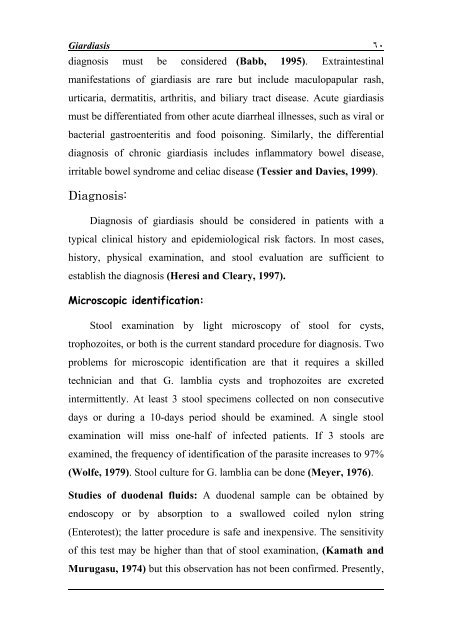Parasites and Biliary stones
Parasites and Biliary stones
Parasites and Biliary stones
Create successful ePaper yourself
Turn your PDF publications into a flip-book with our unique Google optimized e-Paper software.
Giardiasis ٦٠<br />
diagnosis must be considered (Babb, 1995). Extraintestinal<br />
manifestations of giardiasis are rare but include maculopapular rash,<br />
urticaria, dermatitis, arthritis, <strong>and</strong> biliary tract disease. Acute giardiasis<br />
must be differentiated from other acute diarrheal illnesses, such as viral or<br />
bacterial gastroenteritis <strong>and</strong> food poisoning. Similarly, the differential<br />
diagnosis of chronic giardiasis includes inflammatory bowel disease,<br />
irritable bowel syndrome <strong>and</strong> celiac disease (Tessier <strong>and</strong> Davies, 1999).<br />
Diagnosis:<br />
Diagnosis of giardiasis should be considered in patients with a<br />
typical clinical history <strong>and</strong> epidemiological risk factors. In most cases,<br />
history, physical examination, <strong>and</strong> stool evaluation are sufficient to<br />
establish the diagnosis (Heresi <strong>and</strong> Cleary, 1997).<br />
Microscopic identification:<br />
Stool examination by light microscopy of stool for cysts,<br />
trophozoites, or both is the current st<strong>and</strong>ard procedure for diagnosis. Two<br />
problems for microscopic identification are that it requires a skilled<br />
technician <strong>and</strong> that G. lamblia cysts <strong>and</strong> trophozoites are excreted<br />
intermittently. At least 3 stool specimens collected on non consecutive<br />
days or during a 10-days period should be examined. A single stool<br />
examination will miss one-half of infected patients. If 3 stools are<br />
examined, the frequency of identification of the parasite increases to 97%<br />
(Wolfe, 1979). Stool culture for G. lamblia can be done (Meyer, 1976).<br />
Studies of duodenal fluids: A duodenal sample can be obtained by<br />
endoscopy or by absorption to a swallowed coiled nylon string<br />
(Enterotest); the latter procedure is safe <strong>and</strong> inexpensive. The sensitivity<br />
of this test may be higher than that of stool examination, (Kamath <strong>and</strong><br />
Murugasu, 1974) but this observation has not been confirmed. Presently,
















